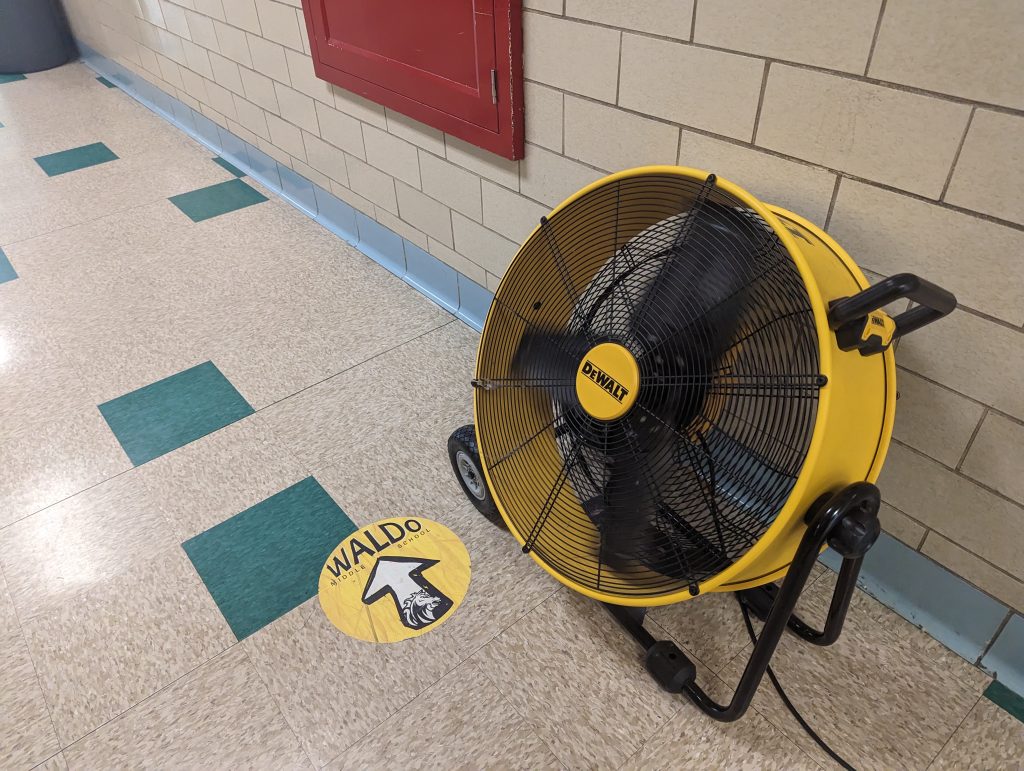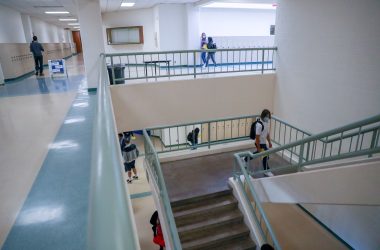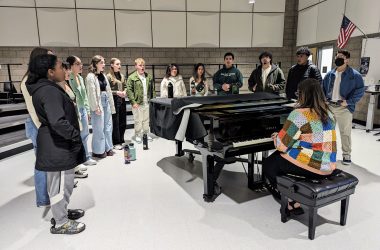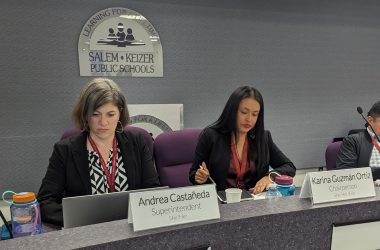Classrooms around Salem are recording temperatures as high as 90 degrees, conditions teachers say are making it harder for students to learn during the final weeks of the school year.
Large fans stationed in some school hallways provide passing relief, but passing periods send hundreds of sweaty teenagers walking between classrooms at local middle and high schools.
Teachers have reported excessive temperatures from “dozens and dozens” of classrooms around the Salem-Keizer School District, according to Tyler Scialo-Lakeberg, president of the Salem-Keizer Education Association. Many are sending photos of thermometers on their desks.
“It’s not OK. We have a law where you can break out windows if you see a dog in a car and yet we’re putting our kids in hot boxes in some situations,” Scialo-Lakeberg said.
Four people at Leslie Middle School filed complaints with Oregon’s Occupational Safety and Health Administration Tuesday saying multiple classrooms had excessive heat and lacked ventilation. One teacher sought parent permission to take classes to a nearby park for some relief from the heat.
At Waldo Middle School, teachers walking the halls after classes Tuesday traded temperature readings with each other. One nearly windowless classroom was at 87 degrees, while others ranged from 80 to 84.
The school was built in 1957 and has air conditioning only in the main office and two classrooms that were originally computer rooms. About 1,200 students attend classes in the single-story building.
In the heat, more students “are putting their heads down and not fully engaging with their classwork,” said Jason Jones, an English teacher and union representative for the school. His classroom reached a high of 85 degrees Monday.
Though the district is near completion on a five-year, $755 million construction blitz that added space or upgraded systems at nearly every school in the district, many schools still lack air conditioning in part or all of the building.
Those include new additions built at some schools, like the hallway added to Waldo in 2020. Cost is often why air conditioning wasn’t added to expansions including Waldo’s, said district spokesman Aaron Harada. He didn’t have a list or count of which of the district’s 65 schools have air conditioning.
Teachers and parents reported multiple other issues contributing to the impact of heat across Salem schools.
Some teachers are assigned classrooms with few windows that were originally meant to be storage spaces or serve other uses. Security regulations intended to prevent school shootings typically prohibit teachers from leaving exterior doors open to add airflow.
“We are asking staff to notify their office manager or custodian if they feel their workspace or classroom is too hot so that Facilities can do an on-site inspection to ensure the ventilation system is functioning as expected,” Harada said in an email.

The high temperatures this week came as some students are taking state standardized tests intended to show whether they’re reading and doing math at grade level.
Multiple studies have shown heat makes it harder for students to learn, with students performing worse on exams on hotter days, according to a research summary by Education Week. Black and Latino students, and low-income students, are far more likely to be in schools with poor air conditioning.
Students learn best at temperatures between 68 and 74 degrees, according to Pennsylvania State University’s Center for Evaluation and Education Policy Analysis. In Salem, temperatures outside reached 88 degrees Monday, 86 Tuesday and 90 on Wednesday.
In response to this week’s heat, the school district’s facilities department increased the amount of outside air brought into buildings at night, when temperatures are cooler, and HVAC teams were resetting systems as needed to ensure optimal airflow and cooling, Harada said.
Hotter temperatures were in part due to pandemic changes to HVAC systems, which increased the number of times air in buildings is refreshed each hour. That required cycling more outdoor air in, raising temperatures when it’s hot outside.
In an email to district employees Tuesday, Chief Operations Officer Robert Silva said facilities would return to pre-pandemic airflow settings, allowing cooler air to remain in buildings longer.
“While we expect this change to help with the temperatures in our schools and classrooms, those schools without air conditioning will still experience warmer classrooms as the outside temperatures increase,” Silva wrote.
Harada said the district is also purchasing hundreds of box fans to give teachers after distributing hundreds more earlier in the school year. He did not respond to a question about why the district waited until temperatures hit 80 degrees to purchase additional fans.
Teachers are not allowed to bring in window air conditioning units or portable swamp coolers.
Despite climate change raising average spring and fall temperatures, adding air conditioning to schools was not a priority of the 2018 voter-approved construction bond, which instead focused on more classroom space, career technical education and security upgrades.
“Cooling did not become a primary goal in the Long-Range Facilities Planning process which included a significant amount of input and review by community members. It also did not become a primary goal of the community in the dozens of community listening sessions and other collaborative work,” he said in an email.
Harada said the district recently entered a contract to complete a districtwide HVAC systems assessment, something that’s been planned for over two years. The assessment originally focused on ventilation and filtration during the pandemic, but the scope expanded because administrators realized they needed to assess heating, cooling and other systems. Harada said a districtwide assessment will be completed by August 2024, though individual schools will get results as they’re developed.
Some schools are waiting on needed parts to arrive to finish or repair air conditioning systems. At McKay High School, the district’s largest, assistant principal Donnie Kim emailed employees Monday morning saying the school’s newly-installed HVAC unit would not be functional for another week. Meanwhile, he said some classrooms were receiving Gatorade jugs filled with ice water, and an industrial fan was pulling air into the school’s east wing.
Teachers in the building reported classrooms at 86 and 88 degrees Monday morning before students arrived, Scialo-Lakeberg said.
Last year, Oregon OSHA finalized rules intended to protect workers from excessive heat which require heat illness training, access to cool water, acclimatization practices and access to shade.
While they’re most often cited for outdoor work like agricultural labor and construction, they apply to most workers indoors when the heat index exceeds 80 degrees, or to those doing “light work,” like office work, at 90 degrees.
The district’s primary administrative office on Northeast Lancaster Drive, where Superintendent Christy Perry and other top-level district administrators work, has central air conditioning which was recently replaced as part of a renovation. Harada said the system was repeatedly failing and replacements of aging air conditioning systems were standard when working on facilities. Schools with aging air conditioning systems also received replacements as part of the recent construction package, he said.
Multiple teachers and parents told Salem Reporter it was unfair to expect students to learn in conditions district administrators don’t routinely work in. Jones said the inequity of the situation at Waldo came up regularly in discussions with other teachers at the school.
The school is majority Latino and houses the district’s newcomer program for refugee and immigrant students who have recently moved to Salem. Teachers said parents of Waldo students are less likely to complain about school conditions than parents in more affluent neighborhoods because they’re often working multiple jobs to make ends meet.
“If you’re an employee of Salem-Keizer, we would like everyone to enjoy or suffer the same temperature,” Jones said.
English teacher Gwen Stromseth opens windows in the morning and leaves lights off all day in her classroom to keep things cooler. Waldo has always been hot, she said, but it’s worsened since the addition of a new wing of the school.
She said she’s tried to get a fan through the district multiple times, but they’ve always run out. She bought a fan with her own money this week, plus popsicles for her students.
“I can’t wait for the supply chain to catch up with the need,” Stronsath said. “My kids are hot now.”
Contact reporter Rachel Alexander: [email protected] or 503-575-1241.
JUST THE FACTS, FOR SALEM – We report on your community with care and depth, fairness and accuracy. Get local news that matters to you. Subscribe to Salem Reporter. Click I want to subscribe!

Rachel Alexander is Salem Reporter’s managing editor. She joined Salem Reporter when it was founded in 2018 and covers city news, education, nonprofits and a little bit of everything else. She’s been a journalist in Oregon and Washington for a decade. Outside of work, she’s a skater and board member with Salem’s Cherry City Roller Derby and can often be found with her nose buried in a book.









